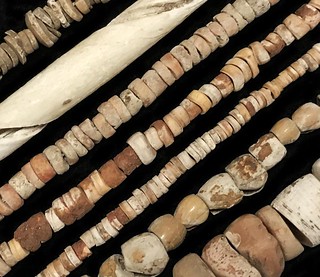
PREV ARTICLE
NEXT ARTICLE
FULL ISSUE
PREV FULL ISSUE
SHELL BEAD MONEY IN CALIFORNIAA university of California archaeologist says shells were used as currency on the Southcentral Coast of Santa Barbara as long as 2,000 years ago. -Editor
But an exhaustive review of some of the shell bead record led the UC Santa Barbara professor emerita of anthropology to an astonishing conclusion: The hunter-gatherers centered on the Southcentral Coast of Santa Barbara were using highly worked shells as currency as long as 2,000 years ago.
Although Gamble has been studying California's indigenous people since the late 1970s, the inspiration for her research on shell bead money came from far afield: the University of Tübingen in Germany. At a symposium there some years ago, most of the presenters discussed coins and other non-shell forms of money. Some, she said, were surprised by the assumptions of California archaeologists about what constituted money.
Intrigued, she reviewed the definitions and identifications of money in California and questioned some of the long-held beliefs. Her research led to Gamble argues that archaeologists should use four criteria in assessing whether beads were used for currency versus adornment: Shell beads used as currency should be more labor-intensive than those for decorative purposes; highly standardized beads are likely currency; bigger, eye-catching beads were more likely used as decoration; and currency beads are widely distributed.
Gamble's research not only resets the origins of money in the Americas, it calls into question what constitutes
Recent research on money in Europe during the Bronze Age suggests it was used there some 3,500 years ago. For Gamble, that and the Chumash example are significant because they challenge a persistent perspective among economists and some archaeologists that so-called
To read the complete article, see:
Wayne Homren, Editor The Numismatic Bibliomania Society is a non-profit organization promoting numismatic literature. See our web site at coinbooks.org. To submit items for publication in The E-Sylum, write to the Editor at this address: whomren@gmail.com To subscribe go to: https://my.binhost.com/lists/listinfo/esylum All Rights Reserved. NBS Home Page Contact the NBS webmaster |

